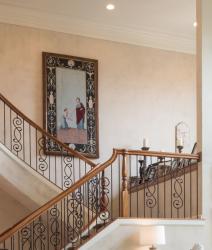Classic
I think I may not be the majority in this (having been raised in Europe and living there until I was an adult); it was part of our culture! Most people had at least one or more tapestries that we’re mostly heirlooms passed on from generation to generation! With styles changing and going more contemporary and minimalist, many people (especially the younger generation) may not be into this. However, a great tapestry can add some interest and character to certain places, even if they are not an heirloom or a rare antique. I have used them as signature pieces in rooms to add some interest. Elke Koch, Elke Koch Interiors.
Tapestries may not be for everyone, but they have been a form of art and expression through the ages. They will always be regarded by many as incredible works of art. Dede Fratt, Fratt & Bush Home.
Tapestries have been found dating back to ancient Greece, but it was in the 14th century that tapestries became widely popular for making a grand statement and their portability. They are definitely a design classic for creating a focal point in a room. The landscape tapestry is enjoying a resurgence, however, tapestries also come in many contemporary designs, so the design options are limitless.
Tapestries bring dimension to a space and are a terrific option whether you need a large format or an interesting accent to make your home into a castle. Gigi Lombrano, Gigi Lombrano Interiors.
Tapestries are the fabric art you see hanging in cathedrals and castles. Historically, these textiles told a story or relayed a point of view. Today, tapestry artists have broadened the art form allowing for a new take on form and structure. Contrasting historic tapestries in heavy granite halls that present heraldry and ancient tales with more impressionistic tapestries in a mid-century home make this art form a classic. Geri Hayes, Ideas Only: Color+Lighting+Design.
Tapestries have been used for centuries in homes, churches and palaces. In the past, tapestries were pictures of hunting scenes or biblical scenes and draped over doors, behind thrones or used on castle walls during the winter for insulation. They were also used in churches to depict biblical stories to people that were illiterate. Today’s tapestries continue to be decorative and they have a wide variety of uses. Tapestries are a great way to add drama and texture to a space. They can be used behind a sofa, on a double-story wall beside a staircase, on any large wall, or behind a bed for a makeshift headboard. Tapestries are a great way to include a rich historical scene into a space or a contemporary design. Tapestries are a great go-to design element for texture and drama and will continue to be a classic design element. Barbara Collins, Barbara Collins Interior Design.
I think beautiful woven tapestries will always be at home in grand spaces. I recently helped a client frame a beautiful designer scarf to hang in her living room. It looks fresh and timeless. Teddy Karl, The Great Cover-Up.
Tapestries are classic pieces of art. Different forms of tapestries have been made popular by European weavers during the medieval, Arts and Crafts, renaissance and ancient Egyptian eras. In the 13th and 14th centuries, the church used tapestries as a way to depict bible stories, and later to illustrate historical events. Today, tapestries display lively designs that bring an interior space to life, much like the revival of wallpaper. Modern tapestries include mandalas, mosaics, flowers and other types of stimulating patterns. Tapestry designs can now even be found in the fashion industry. Although the use of modern wall tapestries in homes will soon burn out, classic tapestries will live on forever. Natalie Slavik, YouTopia Designs.





